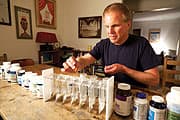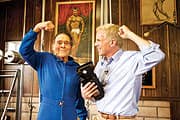Life Extension Magazine®
Life Extension® members will find a kindred spirit in documentarian Mark Wexler, whose latest film, How to Live Forever, takes viewers on a fascinating journey into the world of anti-aging. Wexler is the man behind the famous documentaries Seeing Double, about the annual Twins Days festival in Twinsburg, Ohio, and most recently Tell Them Who You Are, a 2005 documentary about Wexler and his father that landed on several Top 10 film lists that year. While Life Extension members may be familiar with a few of the better-known personalities featured in the documentary, including world-famous fitness pioneer Jack LaLanne, esteemed author Ray Bradbury, and Cambridge biogeneticist Dr. Aubrey de Grey, what viewers may find most compelling are the extraordinary lives of the men and women in their nineties and beyond who are living full, active lives. No doubt poised to be the breakout star of the movie is Buster Martin, a 101-year-old irascible Englishman who runs marathons. “Buster obviously has lots of great genes working in his favor,” Wexler says. “But he has one of the main characteristics that many healthy people in their nineties have, namely they are still active and engaged in the world. Buster still has a day job washing vans for a local company.” If a 101-year-old van-washing marathoner seems like a one-off genetic lottery ticket, there are many, many others in the film who believe they achieved their longevity through healthy living and a healthy attitude. Aging Gracefully
“One of the more remarkable people I came across was Ellsworth Wareham,” Wexler says. “Wareham is a 94-year-old cardiothoracic surgeon from Loma Linda, California. He still assists in surgery and credits his diet and exercise for keeping him in good health. In addition, the community that Wareham lives in adheres to a strict religious policy of forced rest on Saturday. That day really calms him down, and his belief system gives him comfort and support.” Then, of course, there’s the late, great Jack LaLanne, who practically bursts off the screen with energy. In one of the more astounding moments in the film, LaLanne puts Wexler through one of his workouts, and it is clear that the 94-year-old might have a little more pep in his step than the director half his age. “I watched my mom exercise with Jack on television as a kid so it was amazing to do that,” Wexler explains. “He was very funny and he has one of the best lines I’ve ever heard. When I asked him if he loves to exercise, he said to me, ‘I hate to exercise. It’s very hard to leave a warm bed and a hot woman for a cold gym.’” Having a great sense of humor was another characteristic the filmmaker noted many of the elderly subjects in his film possessed. Inspiration for a Documentary
Wexler says the recent passing of his mother, followed closely by the arrival of his AARP card, got him thinking about life and death and eventually led to the making of this film, which took three years to put together. “Aging is a difficult subject for a lot of people to think about and talk about, including me,” he says. “I hope that this movie brings some lightness to the subject and that it maybe helps people feel inspired about what is possible when it comes to living a long, full life.” In a small twist of irony, Wexler notes that making a movie is very nerve-racking and probably ages someone a great deal. Fortunately, throughout the shooting of the film, he spent time with dozens of centenarians who had pointers on living a long time. He also visited a few “blue zones,” which are areas on earth that have an unusually high life expectancy for humans. Two of the most prominent “blue zones” are Iceland and Okinawa, Japan. “I loved Iceland as a country,” Wexler says. “The people I met there on the journey were some of the most interesting and inspiring that I came across. For men, Iceland has the highest life expectancy rate in the world, with an average life expectancy of over 80 years.”
While in Okinawa, Wexler discovers that among many of the locals there is a sharp distinction between longevity and living a long life. According to one, long life is simply living, whether it’s in a bed or in a wheel chair. Essentially, it’s merely surviving. Longevity is maintaining your health and your activity level until the day you die. This philosophy becomes most apparent when Wexler takes his cameras along to follow a ninety-year-old Okinawan fisherman who gets up every day, rows his boat out to his fishery, and sets up his own nets by diving under water, swimming, and holding his breath. It is an astonishing display of what is possible as the limits of aging are pushed. Scientists have pointed to a number of factors as to why Okinawans enjoy particularly impressive longevity. The local diet, which consists largely of very nutrient-rich, low-calorie foods and sea vegetables, is one of the main reasons, as well as environmental issues, genetic inheritance, and lifestyle. In addition to speaking with centenarians, Wexler talked with some of the leading minds in anti-aging science, most notably Aubrey de Grey and Ray Kurzweil. “I think a lot is possible with life extension,” Wexler says. “I just think some things might take a little longer to develop than some of the experts predict. We’ve already increased the average life span in the last hundred years greatly. I think we need to look at everything that is being done and learn from it.” This last sentence, of course, begs the question: What did Wexler learn from the experience of making this film? And has he incorporated any lessons from the people he talked to in his own life? The answer is yes. “I’ve learned that for many of these centenarians and active people in their nineties, they take everything in moderation,” he says. “It’s not only about the foods that you ingest, but it’s also how you see the world and how you think about things. One of the biggest takeaways I got was that your attitude can have as much to do with your health as what you’re eating and breathing. I also tend to try and eat less and have some smaller meals throughout the day instead of a few big meals. And I supplement with a multivitamin, CoQ10, and vitamin D3.” What will you take away from this incredible documentary? See it in a theater near you to find out. If you have any questions on the scientific content of this article, please call a Life Extension® Health Advisor at For more information, visit the movie’s website at www.liveforevermovie.com The film was released in Palm Springs in January 2011. |




